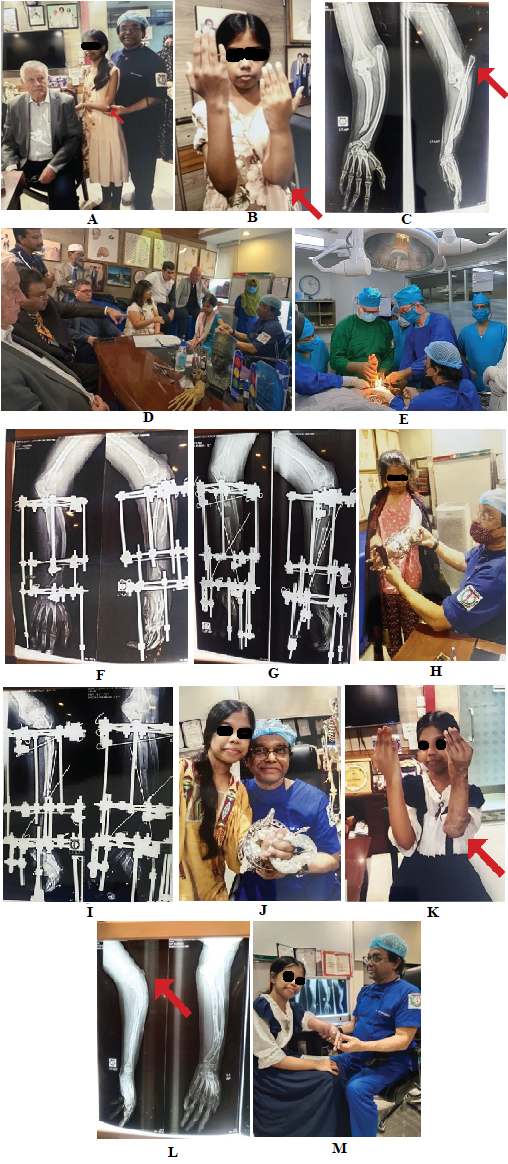MOJ
eISSN: 2374-6939


Clinical Report Volume 15 Issue 4
1Prof. Ph.D, Chief Consultant, Bari-Ilizarov Orthopaedic Centre, Visiting and Honored Prof., Russian Ilizarov Scientific Centre, Kurgan, Bangladesh
2Medical officer, Bari-Ilizarov Orthopaedic Centre; PhD resident in Tashkent scientific research institute of orthopaedics and traumatology, Uzbekistan
3MD, FCPS, Prof., Bari-Ilizarov Orthopaedic Centre, Bangladesh
Correspondence: Dr Md Mofakhkharul Bari, Bari-Ilizarov Orthopaedic Centre, 1/1, Suvastu Shirazi Square, Lalmatia Block E, Dhaka-1207, Bangladesh, Tel +8801819211595
Received: August 01, 2023 | Published: August 14, 2023
Citation: Bari MM, Bari AM, Shayan R, et al. Diaphyseal aclasis, severely migrated Lt radial head with radial bow deformity and ulnar shortening with deformity-A case report treated by Ilizarov technique. MOJ Orthop Rheumatol. 2023;15(4):148-149. DOI: 10.15406/mojor.2023.15.00636
diaphyseal aclasis, ulnar shortening, congenital dislocation, radial deformity, Ilizarov
Congenital dislocation of the radial head in posterolateral dislocation is progressive and is a common deformity. Radial head is bowed and at wrist radial deviation is restricted and ulnar deviation is increased. Diaphyseal aclasis produces deformities of the forearm, creating problems in the elbow which is ugly to see as well as in the wrist; this case that we treated is severely deformed case of a 12 years old girl who is skeletally immature patient. We treated this case by Ilizarov technique by pulling down the radial head gradually upto the capitellum and second stage surgery is done by changing the Ilizarov frame and doing corticotomy in the upper ulna by putting two 1.5 olive wires in two directions, which is pulled down up to the distal radius.1,2
Lt radial head is 4 cm migrated upward with bowed radius and deformity and 5 cm shortening of ulna in relation with radius distally.
Classification:
We follow the classification of Masada and Ono in MHE.
Type I: Ulna is short, osteochondroma formation at the distal ulna.
Type IIA: Ulna is short, osteochondroma formation at both proximal radius and distal ulna, radial head dislocated.
Type IIB: Ulna is short, osteochondroma formation at the distal ulna, radial head dislocated.
Type III: Radius is relatively shorter to the ulna, osteochondroma formation at the distal radius.
We treated this case in presence of kurgan, Russian Specialists with Prof. V.I. Shevtsov (former Director of RISC, RTO), Prof. K. I. Novikov, Prof. Denis Mokhovikov and Indian orthopaedic surgeons including Prof. Manish Dhawan of Sir Ganga Ram Hospital, Delhi and Dr Shamsul Hoda from Patna and other Kurdistan, Iraq Prof Omer Barawi and Uzbekistan specialists Dr Habib, Mohammad Hani Alsharif and Dr Sharof Davirov on the day of 25th Anniversary of Bari-Ilizarov Orthopaedic Centre on December 29,2022 we operated this case after evaluating preoperatively. We planned the case how to do the surgery, because it is not a normal case in compression with other diaphyseal aclasis. We thought about the quality of life and complications that may happen.
Discussion of this difficult diaphyseal aclasis case with foreign faculties
Procedure
A congenitally migrated radial head irreducible manually or surgically because of adaptive changes in the soft tissues and the absences of normal surfaces for articulations with ulna and humerus. Open reduction of upper migrated radial head and reconstruction in childhood are not advised. Any resection of the radial head should be postponed until growth is complete. That is why Ilizarov technique is the best option and solution for this kind of diaphyseal aclasis and deformity correction.4,5
Ilizarov fixator is an effective and reliable method of treatment for diaphyseal aclasis and deformity.

Case 1
RISC, RTO (Russia), Sir Ganga Ram Hospital (Delhi), Anwar Shexa private Hospital - Slemani - Kurdistan region of Iraq, Bukhara State Medical University (Bukhara) and Samarkand state Medical Institute (Samarkand, Uzbekistan), Samarkand branch of the Republican Specialized Scientific and Practical Medical Center for Traumatology and Orthopedics, Samarkand, Uzbekistan.
The authors declare no conflicts of interest.

©2023 Bari, et al. This is an open access article distributed under the terms of the, which permits unrestricted use, distribution, and build upon your work non-commercially.